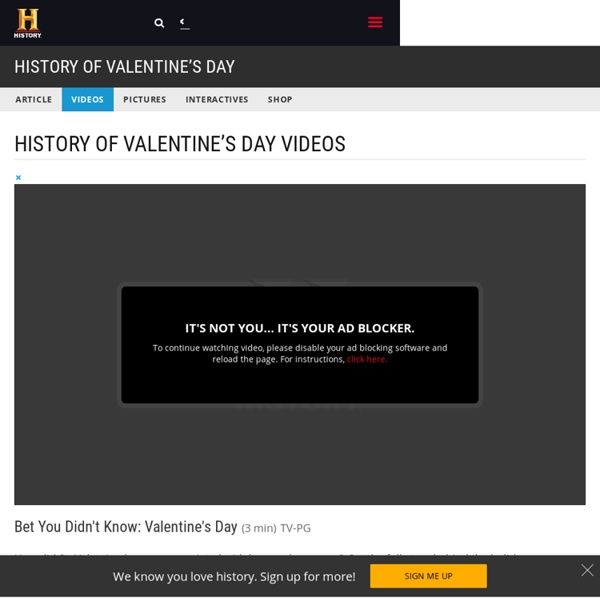Bet You Didn't Know: Valentine's Day Video - History of Valentine’s Day

a fun way to learn English
6 Surprising Facts About St. Valentine
Elizabeth Hanes A man named Valentinus was martyred on February 14 late in the third century A.D.—this much we know. But when it comes to details about the life of St. St. 1. 2. 3. 4. 5. 6.
of Valentine’s Day - Valentine’s Day
My TV provider is not listed. Why not? We are currently working on adding more TV providers. Why do I need to log in to watch some video content? Viewers who verify their subscription to a TV provider get access to a deeper catalog of video content, including more full episodes. I am able to watch on TV. This service is only available through participating TV providers. How much does it cost to access all of the video content? Accessing video content is free, however, you will need to verify your TV provider subscription by logging in in order to access all of our video content. Can I watch videos if my TV provider isn't currently supported? Yes! What kind of programming is available if I log in? You will get access to more full episodes than ever before. How often is new video added to the website? There will be new episodes and web exclusives added every day. How quickly does a new episode get added after it airs on TV? Is there a limit to how much video I can watch on your website?
Valentine's Day Worksheets and Activities
Lanternfish is adding several new Valentine's Day worksheets this year. Just click on the worksheet below. It may take a while to open as most of the files are MS Word documents. Happy Valentine's Day! Word Scramble: Students try to find as many words as the can using the letters from HAPPY VALENTINE'S DAY. Happy Valentine's Day Valentine's Day Crosswords Two crosswords to review Valentine's Day vocabulary. Valentine's Crossword 1 Valentine's Crossword 2 Word Search Find eighteen Valentine's Day words in this word search: Saint Valentine's Day Word Search Valentine's Day Rhymes Simple riddles students solve by finding the rhyme. Valentine's Day Rhymes Monster Valentine's Day Cards: Students write Valentine's Day cards to each other: Monster Valentine1 Monster Valentine 2 Monster Valentine 3 Monster Valentine 4 Broken Hearts: Mend the Broken hearts by unscrambling the words. Broken Hearts Relationships (Adult Classes): Relationships Crosswords 1 Relationships Crosswords 2
Talk2Me English : My Valentine - A fun lesson for Valentine's day
I discovered the song 'My Valentine' by Paul McCartney this week and thought it would be perfect for a Valentine's day lesson. The song is so romantic ♥ My lesson ended up being rather funny and very lively, I hope your students will enjoy it as much as mine did :-) Level: IntermediateLesson activities: Talking about Valentine's day, using sign language to learn vocabulary, listening practice and fill the blanks exercise. Warm up questions: 1. What do you know about Valentine's day?2. Task 1Tell students that you are going to show them a You Tube video of a song by Paul McCartney called 'My Valentine'. Task 4Hand out the 'fill the gaps' exercise, play the song again from the beginning and get the students to complete the missing words. Task 5 - DiscussionDiscuss what the general meaning of the song is. Quick quiz - Look at the lyrics and:1. Happy Valentine's day ♥
Valentine by Carol Ann Duffy – a lesson
It’s Valentine’s Day tomorrow, and although I don’t normally do anything for it, I thought that this year I would take the opportunity to share one of my favourite poems with my students. Here’s the plan in case you want to do it too. Ask your students what day it is, and whether anything special happens on this day in their country. What kind of gifts do people normally give for Valentine’s Day? Give each group the word cloud. Show them an onion. Ask the students to close their eyes and put their heads on the desk (but try not to fall asleep!). Ask them to discuss how similar the poem was to their ideas. You can then do some pronunciation/speaking work. They talk about why you pause in those places – it’s because of line/stanza breaks, and also phrases within the lines. They can chose whether to read Valentine, or an anti-Valentine poem. In groups with other students who have chosen the same poem, they practise reading it. Happy Valentine’s Day! Like this: Like Loading... Related
3 activities for Valentine's day | Online TEFL Training
Whoops! You’ve completely forgotten that Valentine’s Day is round the corner and you haven’t planned anything with a romantic theme for your classes. Don’t panic – Here are 3 last-minute love lessons / activities for you to try which require very little preparation. TIP: Not all learners feel comfortable talking about their private lives and relationships. Briefly introduce the concept of ‘speed dating’. Great for: 2nd conditionals “If you were to go out with me, you’d have the night of your life.” Create a simple handout on an A4 sheet of paper. Who was the man? Who was the woman? Where were they were they met? What was he doing when they met? What did they say to each other? What did they think of each other? What did they do after they met? What happened in the end Hand a sheet to each student and ask them to write their name at the top of the sheet and an answer to the first question.Wait for all students to finish, ask them to fold the sheet below their answer. Who should pay the bill?
Related:
Related:



